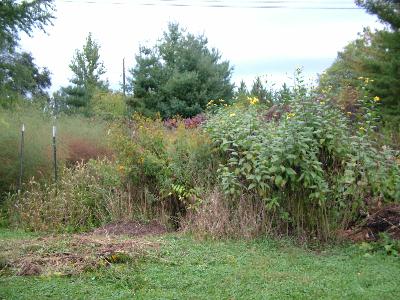A view of the north beds shows an area untouched by human hands from last year until yesterday. The asparagus on the far left was tended and harvested in the spring, but the three beds to the right were probably not walked through until Anneliese started cleaning out a bed full of tansy and goldenrod. Next to the asparagus, the bed with the t-posts was last year a bed of tomatoes, carrots and greens, Anneliese’s first attempt at growing her own vegetables. Now it’s all weeds except for some volunteer Chadwick tomatoes that Anneliese found when she started cleaning up. There were some beautiful ripe edible fruits on a couple plants, but the rest of the bed was weeds. The tansy and goldenrod infested bed is next to that. The fourth bed over is mostly sunchokes – Jerusalem artichokes (Helianthus tuberosus).
The sunchokes and the tansy both have a weed-like existence in the garden. I love the sunchokes. I hate the tansy. I purposely brought them both into the garden. The sunchokes, which are actually a sunflower with an extremely attractive yellow flower, came from Geoff’s work at Nokomis Gardens, which was located next to the Michael Fields Agricultural Institute in East Troy, Wisconsin. For the last several years, I’ve kept them confined to an area alongside the compost area. I’ve tried to define them into a bed, and I’ve been somewhat successful. They spread and are quite hard to kill, or conversely, quite easy to maintain if you actually use them as a vegetable. We harvest them, but not often enough. They make an excellent substitute for water chestnuts. When harvested in the spring they are a great raw snack, and they can be cooked. We haven’t found them very exciting cooked by themselves, but blended with mashed potatoes, they are quite palatable.
The story of the tansy (Tanacetum vulgare) goes back 20 years to Anneliese’s time in the Girl Scouts. Judy was a Scout mother back then and was involved in many Scout activities. One time I accompanied the troop on trip to a farm near Antigo, Wisconsin. On a wagon ride on a rural road, the woman who owned the farm mentioned that tansy was cut and crushed and rubbed onto the horses to be used as a repellent for horseflies. Everyone thought that was interesting and the yellow tightly clustered flower heads sure were pretty.
So next garden season I actually ordered some tansy seeds. I didn’t realize that I could have easily found tansy free for the taking alongside almost any county road near my house. However, where I really screwed up was that I didn’t know how well tansy was going to thrive. Establishing it in my garden was stupid. It grows quickly. It has a very difficult root to remove, and if left to grow to maturity the stem is wood-like and the root clump is huge. It spreads by rhizomes and it puts out thousands of seeds. It is one of my most hated weeds to deal with.
For all its bad qualities, tansy has some plusses. When you crush it, the oils smell great. It has a rich outdoorsy herbal smell that is quite pleasant. It really does have insect repelling characteristics. Occasionally I’ll crush it and catmint together and rub the leaves onto my head and shoulders to keep away little flies and gnats. It seems to help. It is a very pretty plant, but I would be happy to never see it in my yard again.

